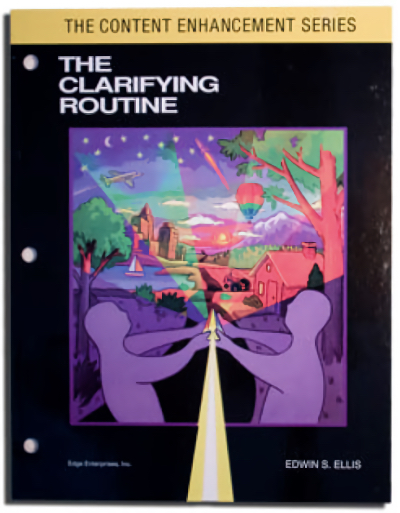The Clarifying Routine

Teachers use the Clarifying Routine to focus on a topic and then explore related details and the topic’s connection to critical concepts and ideas. This routine helps students master the meaning of targeted words and phrases.
All students, including English language learners and those with LD, whose teachers used the Clarifying Routine had significantly higher overall test scores than when the routine was not used. In studies with students in grades 4-6, students with high socioeconomic level improved by 14%; students with middle socioeconomic level improved by 30%, and students with low socioeconomic level improved by 20%.
Author(s):Edwin S. Ellis
Publication & Purchasing Info: University of Kansas, Center for Research on Learning
KU CRL Online Store
Resources:
The Story Behind the Clarifying Routine from author Ed Ellis:
Mike Pressley, Jan Bulgren, and the KISS Principle (Keep It Simple Sailor) inspired the development of the Clarifying Routine. The graphic organizer used in conjunction with this instructional routine was originally called a “metacab.” [META meaning knowledge of and CAB, short for vocabulary]. The metacab was designed as both a tool for teaching vocabulary and as a tool for teaching about the information structure of vocabulary to intermediate and middle-school students. It has subsequently become a tool also used by high school and college students.
The Clarifying Routine was developed with three criteria in mind. The first was to develop a device (the Clarifying Table) that contained embedded semantic prompts designed to cue the teacher or student to employ a select set of information-processing tactics that research had shown to be highly effective when teaching vocabulary. The second was to develop a tool that focused on meaningful understanding of abstract concepts. The third criterion was simplicity. Like the LINCS Strategy and LINCing Routine, I wanted a device that would be easy for teachers and students to learn to use and would lead to experiences that would make teachers want to learn more of the Content Enhancement Routines.
Author's Thoughts about Content Enhancement Instruction:
When I read Lenz and Bulgren’s first piece introducing the concept of Content Enhancement (CE), I was intrigued, mostly by what seemed to be a new dimension that the KU-CRL was integrating into SIM. I didn’t fully appreciate the elegant simplicity underlying the notion of enhancing content because the article was what one might characterize as a “heavy read,” steeped in theoretical notions and complex analysis of related research. The more I worked with CE materials, however, the more I’ve come to realize what a simple, yet incredibly powerful notion CE represents. Two CE principles are paramount: (a) increasing the learnability of subject-matter is preferable to dumbing it down, and (b) extraordinary teaching that impacts all students should be implemented before taking extraordinary measures such as providing individual accommodations. CE puts the role of accommodations in its proper place –they should be used as a last resort, rather than as the first option. Historically, education has been steeped in the notion that failure to learn is the student’s fault (e.g., the result of a learning disability, poor motivation, etc.). CE redefines failure to learn by adhering to the radical notion that failure to learn is first and foremost a teaching problem, not a student problem.
Teacher and Student Feedback on the Clarifying Routine:
One of the positive trends resulting from the No Child Left Behind legislation was the focus on scientifically validated interventions, that is, those educational practices that have been empirically validated using scientific experimental research methodologies. What is often missing from research reports about the effectiveness of new techniques is information regarding their social validity. In other words, the new practice or procedure may be validated as effective because student achievement improves when it is used, but that doesn’t mean it will be used in the “real world” of everyday classrooms. The new technique may not have social validity because it may be too difficult to learn to use, too time consuming to apply, require too much advance planning, students may not like it, and/or it may require teachers to make radical adjustments in their own teaching philosophy to accommodate its use. Fortunately, the Clarifying Routine seems to have clearly met the “reality” test. I’ve received a lot of emails from teachers and parents expressing appreciation. It’s difficult to be modest and proud at the same time, but I admit it. I’m very proud of the impact this routine has had. It continues to touch the lives of a great many students. Feedback from teachers and students about the Clarifying Routine has been that they want a lot more routines like it. Thus, the empirical and social validity of the Clarifying Routine really served as the catalyst for the development of an extensive range of similar tools, collectively known as the Makes Sense Strategies.
This manual is available through the KU CRL Shop.
Please note that professional development, coaching, and infrastructure support are essential components to effective implementation of SIM instructional tools and interventions. It is highly recommended that you work with a SIM professional developer. See the SIM Event list for sessions or email simpd@ku.edu to learn more.
An accessible version of the documents on this site will be made available upon request. Please contact the KU CRL Professional Development Research Institute, at simpd@ku.edu to request the document be made available in an accessible format.